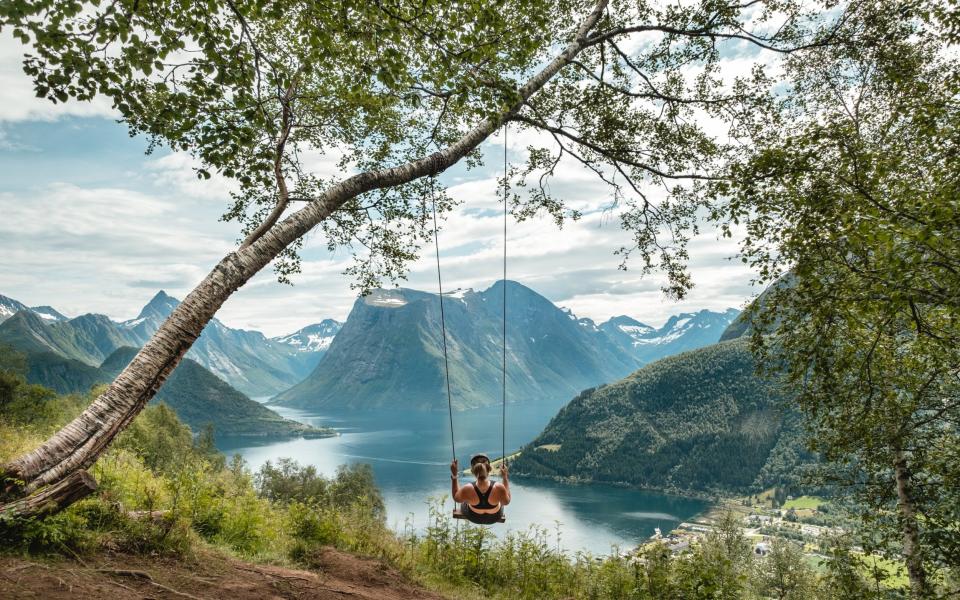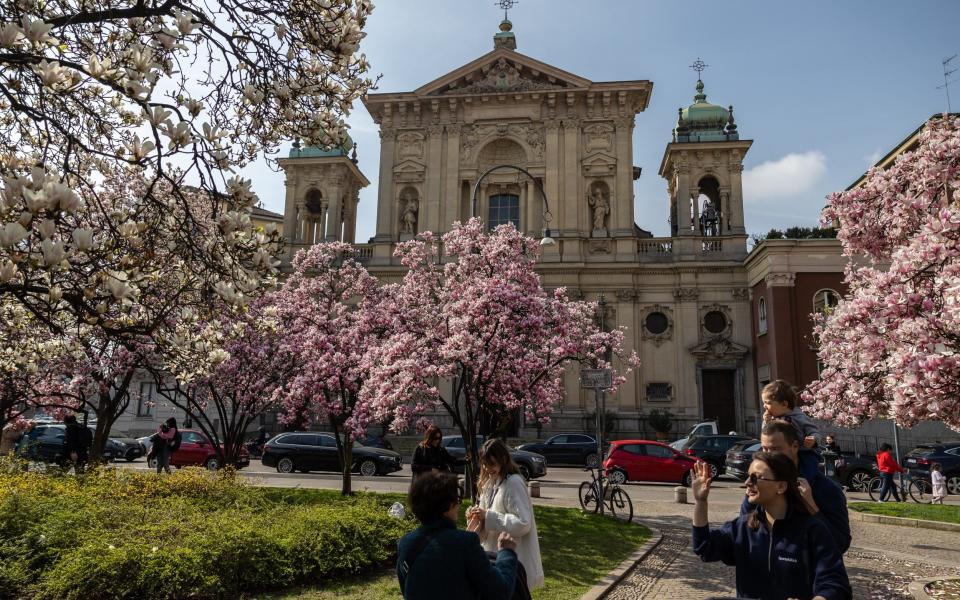Climate change is said to be experienced mostly through online videos; until you’re the one shooting the clip. And increasingly, we get the sense that it’s the holidaymakers who hold the phones.
Take 2023, when forest fires, first in Spain, then in Italy, then in Greece, ravage the countryside, turning villages into inferno and devastating local communities. It has also led to many holidaymakers turning to tour operators to assist with their evacuation.
As our weather conditions continue to change, it seems inevitable that our holidays will change too over the next few decades. People are already exploring more sustainable ways to see the world; such as taking fewer trips, using better modes of transportation, or settling into locally owned accommodation.


But these well-publicized events, combined with the desire to avoid extreme heat or unpredictable weather, can also influence the types of trips holidaymakers take. By 2050, we may be exploring new places, changing our travel season, or admiring slightly changed landscapes, such as the city skyline or the wide blue sea.
Below are seven ways holidays may have changed by 2050.
Your summer vacation may be in Northern Europe (or not in the summer)
The traditional two-week holiday at a resort in France or Spain is already starting to feel uncomfortably hot for some. According to the European Environment Agency, the continent is warming faster than the global average; Extreme heat waves are expected to become much more common. The holiday map is being redrawn for tourists looking for a light glow instead of sunburn.
Unlike the Mediterranean, Northern Europe may be the preferred destination during the summer months. Temperatures in Norway peak between 25 and 30 degrees in July, and plenty of extra sunshine also provides more hours for outdoor activities.
Tour operator Black Tomato has seen an increase in demand from travelers looking to take trips to cooler climates, “especially in July and August,” according to Product Manager Carolyn Addison. Bookings in Scandinavia are up 175 percent this summer compared to last; Norway in particular is proving popular.


Local people are rising to the challenge. New hotel openings, including Oslo’s Sommero, are adding flair to already thriving cities; The little-known beaches of the Baltic Sea provide a quiet alternative to typical resorts in the Mediterranean. And quite wisely, Scandinavian countries are keen to improve their green credentials as they welcome more visitors.
However, if the Costa del Sol is not negotiable, the travel time may need to change. Intrepid Travel CEO James Thornton noted that our holiday seasons are already changing: the company reported an 88 percent increase in bookings in Europe for April and May this year. “Shoulder season,” as it is known, will become the normal travel time for most people. Aside from cooler weather, traveling in May or September remains cheaper, at least for now.
Overwater villas can be underwater
Maldives is the poster destination for honeymooners. This is also an example of the most immediate effects of climate change. This network of low-lying islands is so threatened by any rise in sea level that the government has made the issue a priority and has spent almost half of the national budget on mitigation measures. It’s definitely needed: The World Bank estimates that 80 percent of the country will be completely submerged by 2050.


It is then a matter of survival for hotels and resorts to invest in environmentally friendly practices. Places like Barefoot Eco Hotel are keen to highlight their positive impact. Along with guest-focused initiatives like “responsible snorkeling,” they monitor local marine life in partnership with an underwater charity and source only sustainably grown ingredients.
Time will tell whether the hospitality industry will benefit the islands beyond their economic impact. Either way, visitors of the near future will find that many of the islands are surrounded by sea walls (this is already the case in the capital Malé).
City breaks will be warmer but leafier
Cities will bear the brunt of high temperatures. They act as “heat islands,” sometimes up to 10-15 degrees warmer than surrounding rural areas. If your vacation is often spent walking around a metropolis, you may feel the heat.


Fortunately, there are relatively simple ways to cool cities. A pioneering tree-planting plan in Lisbon cost the city $1.9 million but provided an estimated $8.4 million worth of benefits: providing shade, reflecting sunlight and saving energy.
Milan followed suit, pledging to plant three million trees by 2030; In Basel, government officials went a step further and installed wildflower meadows on every flat roof in the city. By 2050, plans like this could mean city dwellers and tourist travelers could be exposed to the worst of the heat while enjoying greener cityscapes.
We will value the underwater world
New wildlife patterns around the world are affecting the way we encounter native species. If global temperatures rise by 1.5 degrees, the planet could lose up to 90 percent of its underwater coral reefs (which act as a natural flood barrier for low-level islands like the Maldives).
By 2050, marine life may become harder to find. Diving companies are already warning scuba enthusiasts about bleached reefs. Dive Worldwide’s Phil North says: “In certain areas we need to explain to our customers that shallow corals are exhibiting some bleaching. It is part of our responsibility to advise our customers on what to expect on their holidays with the same care and attention to regulation that we give.”
There is also a growing awareness among the scuba diving community of the simple things they can do to protect underwater species: only use reef-safe sunscreen, be careful not to touch or disturb reefs, and book one of PADI’s Eco Centers, resorts, and locations . They demonstrated their commitment to conservation. We hope this will become normal by 2050.
Travel insurance may be more expensive
Last year Rhodes and Corfu suffered particularly devastating forest fires; Airlines and local emergency services scrambled to save thousands of British tourists. This is a terrifying prospect and one that holidaymakers will continue to face.
As global temperatures rise, so do dry, tinderbox conditions that make wildfires more likely; On European islands these can be exacerbated by warm breezes and vegetation. This means travelers should be prepared: Insurance company Staysure recommends keeping the contact information of the person you’re booking with handy while traveling. It’s also worth checking documentation to make sure your policy covers cover for travel disruptions or natural disasters.
As travel insurers increasingly pay out for problems caused by extreme weather events, premium prices will inevitably rise. In a recently published study, Confused.com’s travel insurance expert Alvaro Iturmendi suggested that while consumers are already buying increasingly comprehensive policies, the market is less competitive due to the decline in the number of people holidaying post-pandemic.
UK could be a leader in wine tourism
Once a source of ridicule, the vineyards of southern England are now thriving. Rising temperatures are producing a large number of lauded, refreshing bottles and paving the way for the development of wine tourism.


And not just in the south. Ryedale Vineyards is one of the UK’s most northerly vineyards, located in North Yorkshire: visitors can spend a day here visiting the vineyards and tasting the produce. In the heart of the North Downs at Denbies, there are walks that wind through vineyards and lead to a boutique hotel. It is a reflection of a very promising homegrown hospitality line-up that promises more in the future.
Ski resorts will also become summer resorts
As our weekly reports show, the amount of snowfall in ski-friendly destinations is always talked about. But its unpredictability in the face of climate change means that many enterprising resorts are starting to target summer holidaymakers as well.
Take Whistler in Canada: A place where snow is guaranteed in winter, it is now also a good place for a summer holiday. Itineraries include paddleboarding and exploring farmers markets, taking in spectacular views, and most importantly, not relying on snow. As the uncertainty of white goods in particular decreases, French resorts are following suit. Chamonix now sees many more visitors in the summer than in the winter.
The changes mark a significant shift from the seasonal business model; instead, it opens its Alpine towns to hikers, cyclists and rock climbers year-round. As the active holiday trend intensifies with the heat, more people may plan a summer getaway to the mountains.